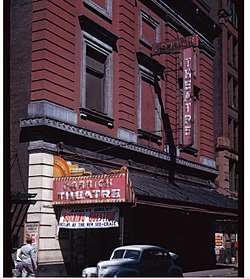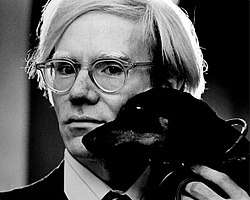Garrick Cinema
| Garrick Cinema | |
|---|---|
 | |
 Location within New York City  Garrick Cinema (New York)  Garrick Cinema (the US) | |
| General information | |
| Architectural style | Late 19th and early 20th century American movements, other |
| Location | 152 Bleecker Street, New York, NY 10012 |
| Coordinates | Coordinates: 40°43′42″N 73°59′58″W / 40.7282°N 73.9994°W |
The Garrick Cinema—periodically referred to as the New Andy Warhol Garrick Theatre, Andy Warhol's Garrick Cinema, Garrick Theatre, Nickelodeon—was a 199-seat movie house[4] located in Greenwich Village at 152 Bleecker Street, Lower Manhattan, New York City.[1][2][3] Andy Warhol debuted many of his notable films (including Bike Boy (1967), Blue Movie (1969), Flesh (1968), Lonesome Cowboys (1968), Loves of Ondine (1967) and others) in this building in the late 1960s.[1][2][3][5] The Cafe Au Go Go was located in the basement of the theater building in the late 1960s, and was a prominent Greenwich Village night club, featuring many well known musical groups, folksingers and comedy acts.
Warhol years
As an advertisement illustrator in the 1950s, Warhol used assistants to increase his productivity. Collaboration would remain a defining (and controversial) aspect of his working methods throughout his career; this was particularly true in the 1960s. One of the most important collaborators during this period was Gerard Malanga. Malanga assisted the artist with the production of silkscreens, films, sculpture, and other works at "The Factory", Warhol's aluminum foil-and-silver-paint-lined studio on 47th Street (later moved to Broadway). Other members of Warhol's Factory crowd included Freddie Herko, Ondine, Ronald Tavel, Mary Woronov, Billy Name, and Brigid Berlin (from whom he apparently got the idea to tape-record his phone conversations).[6]
During the 1960s, Andy Warhol groomed a retinue of bohemian and counterculture eccentrics upon whom he bestowed the designation "Superstars", including Nico, Joe Dallesandro, Edie Sedgwick, Viva, Ultra Violet, Holly Woodlawn, Jackie Curtis, and Candy Darling. These people all participated in the Factory films, and some—like Berlin—remained friends with Warhol until his death. Important figures in the New York underground art/cinema world, such as writer John Giorno and film-maker Jack Smith, also appear in Warhol films (many premiering at the New Andy Warhol Garrick Theatre or the 55th Street Playhouse) of the 1960s, revealing Warhol's connections to a diverse range of artistic scenes during this time. Less well known was his support and collaboration with several teen-agers during this era, who would achieve prominence later in life including writer David Dalton,[7] photographer Stephen Shore[8] and artist Bibbe Hansen (mother of pop musician Beck).[9]
Cafe Au Go Go
The Cafe Au Go Go was a Greenwich Village night club located in the basement of the New Andy Warhol Garrick Theatre at 152 Bleecker Street. The club featured many well known musical groups, folksingers and comedy acts between the opening in February 1964 until closing in October 1969. The club was originally owned by Howard Solomon who sold it in June 1969 to Moses Baruch. Baruch closed the club in October 1969. Howard Solomon became the manager of singer Fred Neil.[10]
The club was the first New York City venue for the Grateful Dead.[11] Richie Havens and the Blues Project were weekly regulars as well as Harvey Brooks who was bass player in residence, The Stone Poneys featuring Linda Ronstadt played frequently. The Grateful Dead played 10 times in 1967 and 3 in 1969. Jimi Hendrix sat in with blues harp player James Cotton there in 1968. Van Morrison, Tim Hardin, Tim Buckley, Joni Mitchell, Judy Collins, Howlin' Wolf, Muddy Waters, John Lee Hooker, Oscar Brown, Jr., the Youngbloods, the Siegel-Schwall Band, John Hammond, Jr.,[12] The Paul Butterfield Blues Band, Michael Bloomfield, Jefferson Airplane, Cream, The Chambers Brothers, Canned Heat, The Fugs, Odetta, Country Joe and the Fish, The Yardbirds, The Doors all played there. Blues legends Lightnin' Hopkins, Son House, Skip James, Bukka White, and Big Joe Williams performed at the club after being "rediscovered" in the '60s. Before many rock groups began performing there, the Au Go Go was an oasis for jazz (Bill Evans, Stan Getz), comedy (Lenny Bruce, George Carlin), and folk music.[13][14]
Current use
The Garrick Cinema and related Cafe Au Go Go buildings were demolished in the 1970s,[15] and the location, at 152 Bleecker Street, was used for a mid-rise apartment building with a Capital One Bank branch at ground level, which are the current buildings (as of September 2017), according to Google Maps.[16]
See also
- Bleecker Street Cinema – nearby at 144 Bleecker Street (1960–1991)
- 55th Street Playhouse – another theater showing Warhol films
- Golden Age of Porn (1969–1984)
- List of New York City Designated Landmarks in Manhattan from 14th to 59th Streets
- National Register of Historic Places listings in New York County, New York
- The Factory – several blocks north of Garrick Cinema
References
- 1 2 3 Staff (2013). "Garrick Cinema 152 Bleecker Street, New York, NY 10012 - Previous Names: New Andy Warhol Garrick Theatre, Andy Warhol's Garrick Cinema, Nickelodeon". CinemaTreasures.org. Retrieved March 23, 2018.
- 1 2 3 Garcia, Alfredo (October 11, 2017). "Andy Warhol Films: Newspaper Adverts 1964-1974 A comprehensive collection of Newspaper Ads and Film Related Articles". WordPress.com. Retrieved March 23, 2018.
- 1 2 3 Staff (August 3, 2010). Fodor's See It New York City, 4th Edition. Fodor's. Retrieved March 23, 2018.
- ↑ Ferguson, Michael (September 30, 2011). Joe Dallesandro: Warhol Superstar, Underground Film Icon, Actor. Google Books. Retrieved March 23, 2018.
- ↑ Comenas, Gary (2005). "Blue Movie (1968)". WarholStars.org. Retrieved March 23, 2018.
- ↑ Colacello, Bob (1990), p. 67.
- ↑ Menand, Louis (January 11, 2010). "Top of the Pops - Did Andy Warhol change everything?". The New Yorker. Retrieved March 25, 2018.
- ↑ Grow, Krystal (September 23, 2014). "Time Lightbox - Stephen Shore: Defacto Photographer of Andy Warhol's Factory". Time. Retrieved March 25, 2018.
- ↑ James, Dagon (2014). Billy Name:The Silver Age Black and White Photographs of Andy Warhol's Factory. Reel Art Press. p. 127. ISBN 1909526177. Retrieved March 25, 2018.
- ↑ Rockprosopography Retrieved March 24, 2018
- ↑ Grateful Dead at Cafe Au Go Go Retrieved March 24, 2018
- ↑ "Archived copy". Archived from the original on March 12, 2003. Retrieved March 24, 2018. Retrieved March 24, 2018
- ↑ Rockprosopography Retrieved March 24, 2018
- ↑ Google images Retrieved March 24, 2018
- ↑ Staff. "Garrick Theatre (1960s) - 152 Bleecker St.; New York, NY". PerformingArtsArchive.com. Retrieved March 25, 2018.
- ↑ Staff (September 2017). "152 Bleecker Street, New York City". Google Maps. Retrieved March 24, 2018.


